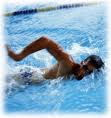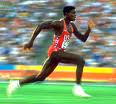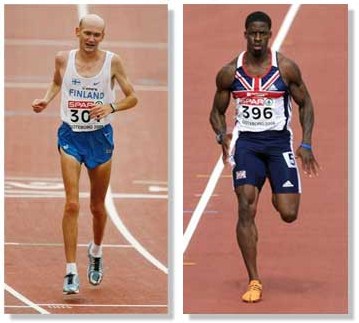|
Best Aerobic Exercise
The best aerobic exercise to achieve the body of your dreams, is the one that will burn excess fat and get you fit, faster than any other aerobic exercise and one you will stick to. Aerobic means 'with oxygen' and aerobic training aims to improve the efficiency of the oxygen system of the body. Many exercises are aerobic and the term usually implies an exercise done at moderate intensity over a relatively long period of time (e.g.jogging 5 km in 20 minutes). You don't need to know all the technicalities, just that it works, and how to select the best aerobic exercise for you. Aerobic exercise is a component of weight loss and fitness but what is the best aerobic exercise? Many exercises are considered aerobic; swimming, running, skipping, walking (as long as it is done at a fast pace), cross-country skiing, and rowing.
Medical DisclaimerPeople have died doing exercise but they have also died doing nothing at all. I think finding the best aerobic exercise is a good thing, but if it kills you because of some unknown medical problem then you will leave friends and family behind who will probably miss you. Death has also been known to stifle your creativity and potential to achieve good in the world:-). See your doctor before beginning this or any kind of exercise programme, especially if you are over 40, and especially get him or her to check for exercise hypertension. There are three ways of doing an aerobic programme:
They gradually increase in intensity.
Here is a list of some of the most common aerobic exercises:
Kenneth Cooper who coined the word aerobics documented 41 aerobics exercises that provide aerobic benefit. His top 5 for the best aerobic exercise are:
How to do it All that's required to get fit and burn calories is to do any of these exercises at a pace where you can talk to someone else while doing the exercise but would prefer not to so you can concentrate on breathing. If that doesn't make sense then you can get more systematic by doing the following (based on Kenneth Cooper's point system). You need to do a minimum of 30 points per week to get a training effect and each of these will give you the minimum 30 points per week. Start out slow and work up to these distances/times.
You don't have to be bound by these figures and any of these could be the best aerobic exercise for you or even a combination of them. For a complete breakdown of the points system for the best aerobic exercise for you look at the various activities listed here 

High Intensity Interval Training (HIIT) More efficient than standard aerobic training, HIIT sits somewhere between traditional aerobics and the Tabata protocol. Long aerobic workouts are often considered the best way to reduce fat especially if the duration goes beyond 30 minutes because this is when fatty acids begin to get burnt for fuel by the body, but studies have shown that HIIT burns fat better. Research has also shown that HIIT produces results 4 times the equivalent of endurance training so basically you can get the same result in 1 hour of HIIT per week as you would in 4 hours of a standard aerobic work out. I am all for working smarter not harder and in this case 'Less is More'. How to do it I have generally tried 9-12 minute HIIT sessions with 3 minutes before and after as a warm-up and cool down period. The 3 to 6 minute block in between is the interval training. The total time with warm up, interval training, and cool down is only 9-12 minutes I usually use telegraph/power poles along the street as my intervals. I warm up for 3 minutes with jogging, then sprint for two power poles, jog lightly for 2 power poles, sprint for two, jog for two until I have used up 3 minutes or 6 minutes (you can choose any figure you like), then jog for a final 3 minutes. You can also vary the rest time if two power poles are not enough, stretching it out to 3 or 4 before sprinting again. The reason this isn't as intense as Tabata training is because sprinting between two power poles will only take about 15 seconds (compared to a Tabata interval of 20 seconds) and walking for the next two to four power poles will take 40 seconds or more (a tabata rest period is only 10 seconds). Therefore HIIT is less intense than Tabata. An alternative to running on the flat is to find a small hill and sprint up it then walk back down, then sprint up again and walk back down and so on. This method has been used successfully by a number of special forces units. If you compete with friends who run on the flat you will leave them behind if you use hills in your training. 
The Tabata Protocol A Tabata Protocol (also called a Tabata Interval) is a form of interval training. Unless you are already extremely fit, don't start training with the full Tabata Protocol. Work up to it as a goal. It was designed for world class athletes (i.e. speed skaters) by Izumi Tabata, a researcher at the National Institute of Fitness and Sports in Japan. He put the skaters on exercise bikes for testing the effectiveness of his method. You will often hear that it is a 4 minute workout, which it is, but there should be a warm-up period of 2-5 minutes and a warm-down of 5 minutes, with the Tabata interval in between. It can be used with running, swimming, cycling, rowing, martial arts and even weight training (There is a growing trend to use kettlebells as an all body workout and they can be easily incorporated into a HIIT or Tabata routine - see http://intense-kettlebell-workouts.com to get the whole story). Tabata is supremely effective at burning fat long after the exercise session is over and doesn't tear down muscle. It will get you fitter, faster than the usual endurance training programme. It has an aerobic effect (improves your bodies ability to use oxygen) and also an anaerobic effect (improves your muscles ability to endure exercise) How to do it We will concentrate on running but you can do it with anything. Jog for 2-5 minutes then sprint all out for 20 seconds then walk for 10 seconds (repeat this 20 second sprint, 10 second walk phase 6-8 times)then jog or walk for 5 minutes (the original Tabata interval had a 2 minute warm-down). I use a gymboss timer to keep track of the intervals (see below) You will find this is difficult to complete and if you go all out you will probably throw up but if you persevere you will become extremely fit and lean. It is excellent for burning fat and continues to do so for hours after the exercise. You can also just start with a 5 minute jog followed by one Tabata interval (20 seconds sprint/10 second walk) then 5 minutes jog. Gradually increase the number of intervals. When you can do 5 to 8 intervals your warm down will be a walk (or crawl:-) because you certainly won't be able to jog. Getting to 4 intervals is relatively easy but the intervals from 5 to 8 will put you into oxygen debt and you will find it hard but enjoyable in a perverse kind of way:-)and you will feel the positive effects within two weeks. You can vary the warm up and warm down period as you get fitter but I suggest you do at least 9 minutes all up(a 3 minute warm up, 3 minutes of Tabata intervals -i.e 6 sets, and 3 minutes warm-down done twice a week has worked for me and allows me to train with weights as well without over-training).
Keeping track of the intervals It is difficult to read a watch when you are sprinting all out so I recommend you get yourself a Gymboss interval timer, they are inexpensive (around US$23 with postage) and Gymboss will deliver them anywhere in the world within a week. They are a very handy piece of kit and easy to use. A Gymboss will beep (or vibrate) when the interval starts and beep when the rest period begins, then beep again when the rest period is finished and it is time to go again and so on. it also records the number of intervals which is handy because when you are tired it is easy to mis-count. Something I have done a few times. You can set the gymboss for any interval period and any rest period and you will find having one a real bonus when you are doing your best aerobic exercise. If you would like to find out more or order a Gymboss timer click on the image below


Our ancestral past For me, HIIT and Tabata typifies a hunter-gatherer exercise system, our ancestral exercise pattern. Short duration bouts of intense exercise followed by easier work and long periods of rest. The best aerobic exercise was the one we did as part of our normal, daily lives. The best aerobic exercise for you is the one you do as part of your life. Much has been made of man the runner as if we spent hours loping across the plains of Africa. It just doesn't make sense to me. Of course there are current examples such as the Tarahumara (Native American people of North-western Mexico)who developed a tradition of running long distances (100 miles) between their various settlements and you will see accounts of Native Americans running down horses over a period of days but these cases are unusual. Aboriginal people in Australia might hunt an animal for days but it would be at a walk (after all they are good at tracking) with the occasional sprint at the end. They would often gorge themselves after a hunt and spend a lot of time sitting or lying and just talking. Their activities at other times included climbing trees, playing games, fixing tools and equipment, ritual warfare against neighbours, raids against other tribes for women or for payback, processing wild foods, hunting, gathering wild food, religious ceremonies that might require hours of dancing and foot stomping. Do you think they ever thought about the best aerobic exercise?
Hunter gatherers walked on average around 14 km per day (9 miles) in pursuit of food. They occasionally jogged, sometimes sprinted, swam or climbed trees and they stayed fit and healthy. Their lifestyle forced them to exercise because the alternative was starvation. Their best aerobic exercise was their daily life. Just because humans are the best animals at endurance pursuits doesn't mean we we're designed to run long distances as a matter of course. It may just be a by-product of some of our other adaptations. If we are going to learn anything from our ancestors it should be that we need to exercise but we should do it intermittently and vary it wherever possible and the best aerobic exercise is the one that mimics our hunter-gatherer past. I believe that is probably HIIT. It is more effective than traditional aerobics and you can mix up the intervals and rest periods which is more in keeping with an intermittent exercise strategy. It is also not as intense as Tabata and is therefore more likely to be more accessible to the greatest number of people and minimises time spent on exercise. Having said that, I prefer Tabata, because it is fast to complete, you feel you have worked out, and it is quick in terms of results. Strangely, I also enjoy it and feel great for most of the day afterwards. Try them all and see what works for you. That is all you really need to know about the best aerobic exercise but here is a question for you...
Five frogs are sitting on a log and four decide to jump into the pond. How many are still on the log? The answer is FIVE because deciding to do something and actually doing it are not the same thing. Go out now and walk or jog for 3 minutes (taking into account what I said in the Medical Disclaimer above), and that is all you have to do and it is a start. If it is not possible now, go tomorrow morning and walk or jog for 3 minutes or as soon as you get checked out by your doctor. The distance is not important, the speed is not important but the act of starting IS important. The best aerobic exercise is the one you start.
InspirationIf you are still making excuses you should watch the following video:
If you need more encouragement, go to the Benefits to Exercise page
here.
Leave Best Aerobic Exercise page and return to Home page
|






